Miniature Fabry-Perot Cavity Based on Fiber Bragg Gratings Fabricated by Fs Laser Micromachining Technique
Abstract
:1. Introduction
2. Theories and Simulations
3. Fabrication
4. Temperature and Strain Response Measurement
4.1. Temperature Response
4.2. Strain Response
5. Conclusions
Author Contributions
Funding
Data Availability Statement
Conflicts of Interest
References
- Huang, Y.; Tao, J.; Xu, H. Research Progress on F-P Interference—Based Fiber-Optic Sensors. Sensors 2016, 16, 1424. [Google Scholar] [CrossRef] [Green Version]
- Chen, H.; Liu, J.; Zhang, X.; Wang, W.; Ma, Z.; Lv, W.; Guo, Z. High-Order Harmonic-Frequency Cross-Correlation Algorithm for Absolute Cavity Length Interrogation of White-Light Fiber-Optic Fabry-Perot Sensors. J. Lightwave Technol. 2020, 38, 953–960. [Google Scholar] [CrossRef]
- Wu, Y.; Zhang, Y.; Wu, J.; Yuan, P. Fiber-Optic Hybrid-Structured Fabry–Perot Interferometer Based on Large Lateral Offset Splicing for Simultaneous Measurement of Strain and Temperature. J. Lightwave Technol. 2017, 35, 4311–4315. [Google Scholar] [CrossRef]
- Li, G.; Ji, L.; Li, G.; Su, J.; Wu, C. High-resolution and large-dynamic-range temperature sensor using fiber Bragg grating Fabry-Pérot cavity. Opt. Express 2021, 29, 18523–18529. [Google Scholar] [CrossRef]
- Avino, S.; Barnes, J.A.; Gagliardi, G.; Gu, X.; Gutstein, D.; Mester, J.R.; Nicholaou, C.; Loock, H. Musical instrument pickup based on a laser locked to an optical fiber resonator. Opt. Express 2011, 19, 25057–25065. [Google Scholar] [CrossRef] [PubMed]
- Wu, B.; Wang, M.; Dong, Y.; Tang, Y.; Mu, H.; Li, H.; Yin, B.; Yan, F.; Han, Z. Magnetic field sensor based on a dual-frequency optoelectronic oscillator using cascaded magnetostrictive alloy-fiber Bragg grating-Fabry Perot and fiber Bragg grating-Fabry Perot filters. Opt. Express 2018, 26, 27628–27638. [Google Scholar] [CrossRef] [PubMed]
- Cui, P.; Zhang, W.; Song, Y. High resolution inclinometer based on vertical pendulum and fiber Bragg grating Fabry–Perot cavity. Chin. Opt. Lett. 2018, 16, 110603. [Google Scholar]
- Zheng, J.; Wang, R.; Pu, T.; Lu, L.; Fang, T.; Li, W.; Xiong, J.; Chen, Y.; Zhu, H.; Chen, D.; et al. Fabry-Pérot cavity based on chirped sampled fiber Bragg gratings. Opt. Express 2014, 22, 2782–2789. [Google Scholar] [CrossRef] [PubMed]
- Carpenter, L.G.; Holmes, C.; Snow, B.D.; Gates, J.C.; Smith, P. Photonic microcantilevers with interferometric Bragg grating interrogation. IEEE Photonics J. 2012, 4, 1387–1395. [Google Scholar] [CrossRef]
- Holmes, C.; Carpenter, L.G.; Gates, J.C.; Smith, P. Miniaturization of Bragg-multiplexed membrane transducers. J. Micromech. Microeng. 2012, 22, 025017. [Google Scholar] [CrossRef]
- Thomas, J.; Jovanovic, N.; Becker, R.G.; Marshall, G.D.; Withford, M.J.; Tünnermann, A.; Nolte, S.; Steel, M.J. Cladding mode coupling in highly localized fiber Bragg gratings: Modal properties and transmission spectra. Opt. Express 2011, 19, 325–341. [Google Scholar] [CrossRef] [Green Version]
- Ioannou, A.; Theodosiou, A.; Caucheteur, C.; Kalli, K. Direct writing of plane-by-plane tilted fiber Bragg gratings using a femtosecond laser. Opt. Lett. 2017, 42, 5198–5201. [Google Scholar] [CrossRef]
- Zhou, K.; Dubov, M.; Mou, C.; Zhang, L.; Mezentsev, V.K.; Bennion, I. Line-by-Line Fiber Bragg Grating Made by Femtosecond Laser. IEEE Photon. Technol. Lett. 2010, 22, 1190–1192. [Google Scholar] [CrossRef] [Green Version]
- Williams, R.J.; Krämer, R.G.; Nolte, S.; Withford, M.J. Femtosecond direct-writing of low-loss fiber Bragg gratings using a continuous core-scanning technique. Opt. Lett. 2013, 38, 1918–1920. [Google Scholar] [CrossRef] [PubMed]
- Zhu, Y.; Zhang, Y.; Xue, L.; Jiang, P.; Wang, C. The fabrication mechanism and spectral characteristics of Fiber Gratings fabricated by point-by-point direct-writing based on femtosecond laser pulses. In Proceedings of the International Conference on Optical Communications and Networks (ICOCN), Huangshan, China, 5–8 August 2019; pp. 1–6. [Google Scholar]
- Åslund, M.L.; Jovanovic, N.; Groothoff, N.; Canning, J.; Marshall, G.D.; Jackson, S.D.; Fuerbach, A.; Withford, M.J. Optical loss mechanisms in femtosecond laser-written point-by-point fibre Bragg gratings. Opt. Express 2008, 16, 14248–14254. [Google Scholar] [CrossRef] [PubMed] [Green Version]
- Theodosiou, A.; Lacraz, A.; Polis, M.; Kalli, K.; Tsangari, M.; Stassis, A.; Komodromos, M. Modified fs-Laser Inscribed FBG Array for Rapid Mode Shape Capture of Free-Free Vibrating Beams. IEEE Photon. Technol. Lett. 2016, 28, 1509–1512. [Google Scholar] [CrossRef]
- Theodosiou, A.; Lacraz, A.; Stassis, A.; Koutsides, C.; Komodromos, M.; Kalli, K. Plane-by-Plane Femtosecond Laser Inscription Method for Single-Peak Bragg Gratings in Multimode CYTOP Polymer Optical Fiber. J. Lightwave Technol. 2017, 35, 5404–5410. [Google Scholar] [CrossRef]
- Lu, P.; Mihailov, S.J.; Ding, H.; Grobnic, D.; Walker, R.B.; Coulas, D.; Hnatovsky, C.; Naumov, A. Plane-by-Plane Inscription of Grating Structures in Optical Fibers. J. Lightwave Technol. 2018, 36, 926–931. [Google Scholar] [CrossRef]
- Theodosiou, A.; Hu, X.; Caucheteur, C.; Kalli, K. Bragg Gratings and Fabry-Perot Cavities in Low-Loss Multimode CYTOP Polymer Fiber. IEEE Photon. Technol. Lett. 2018, 30, 857–860. [Google Scholar] [CrossRef]
- Chah, K.; Kinet, D.; Wuilpart, M.; Mégret, P.; Caucheteur, C. Femtosecond-laser-induced highly birefringent Bragg gratings in standard optical fiber. Opt. Lett. 2013, 38, 594–596. [Google Scholar] [CrossRef]
- Huang, B.; Shu, X. Ultra-compact strain- and temperature-insensitive torsion sensor based on a line-by-line inscribed phase-shifted FBG. Opt. Express 2016, 24, 17670–17679. [Google Scholar] [CrossRef] [PubMed]
- Yang, K.; Liao, C.; Liu, S.; He, J.; Wang, J.; Wang, Y. Optical Fiber Tag Based on an Encoded Fiber Bragg Grating Fabricated by Femtosecond Laser. J. Lightwave Technol. 2020, 38, 1474–1479. [Google Scholar] [CrossRef]
- Kashyap, R. Fiber Bragg Gratings; Academic Press: New York, NY, USA, 2010; pp. 149–151. [Google Scholar]

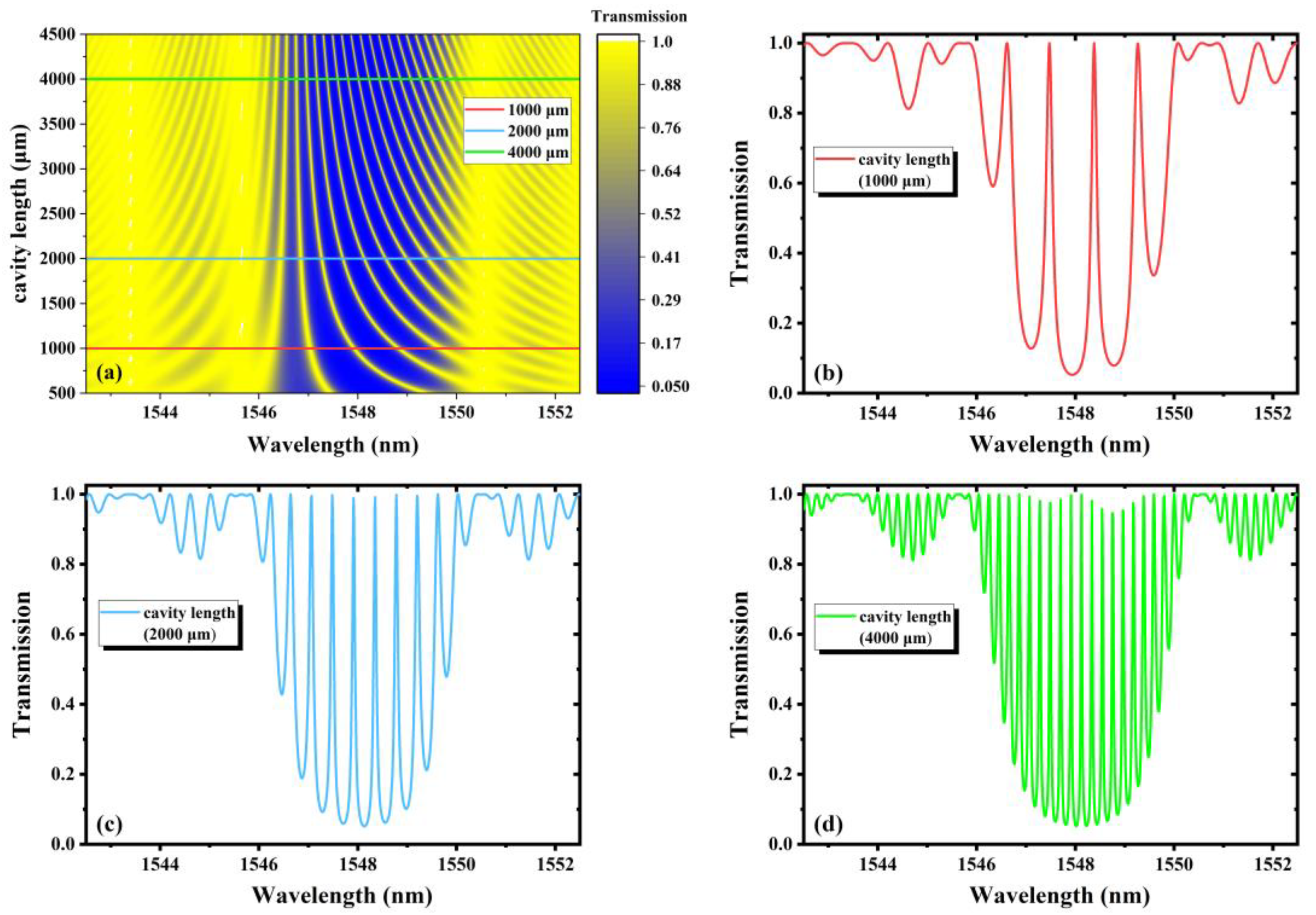
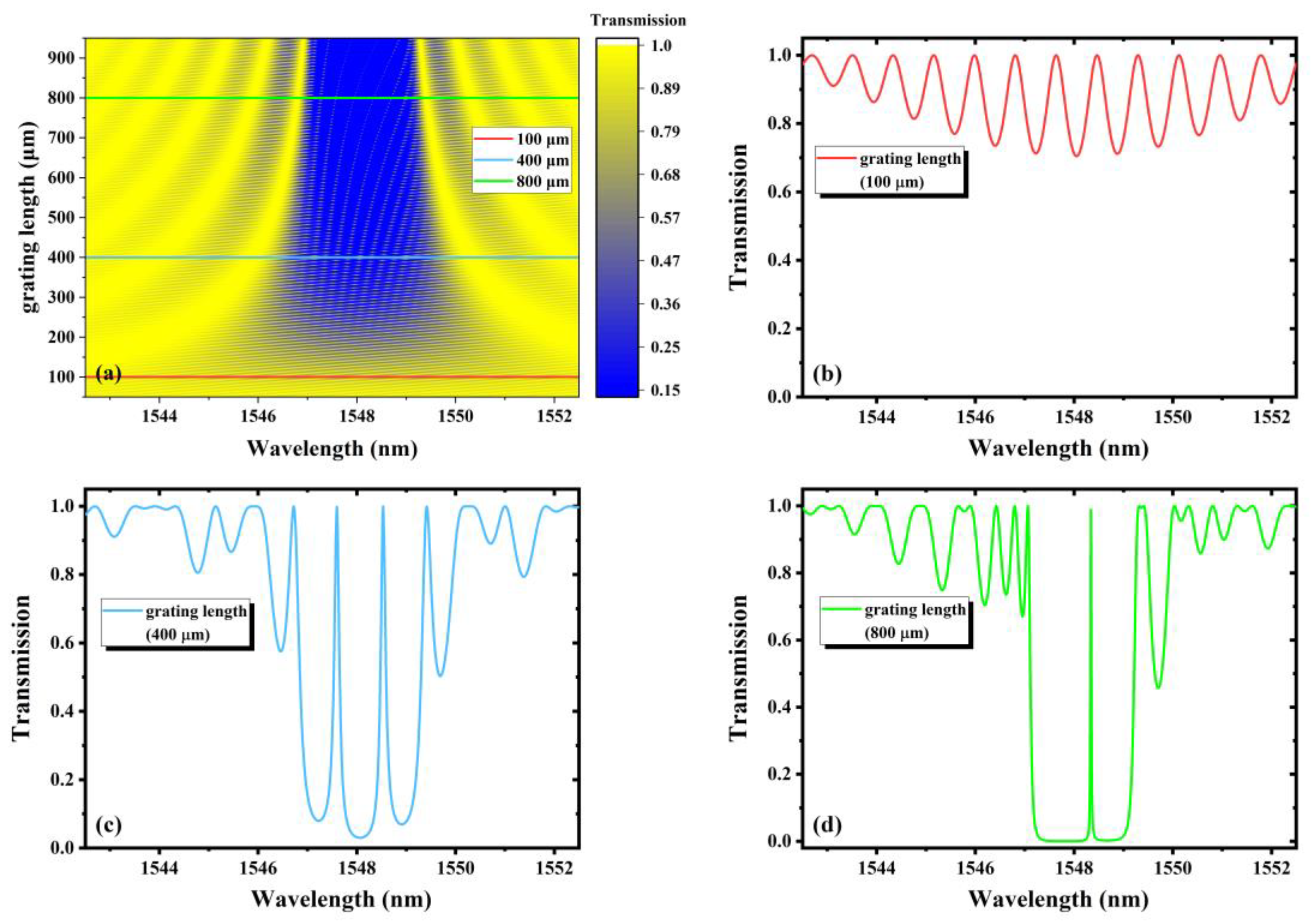
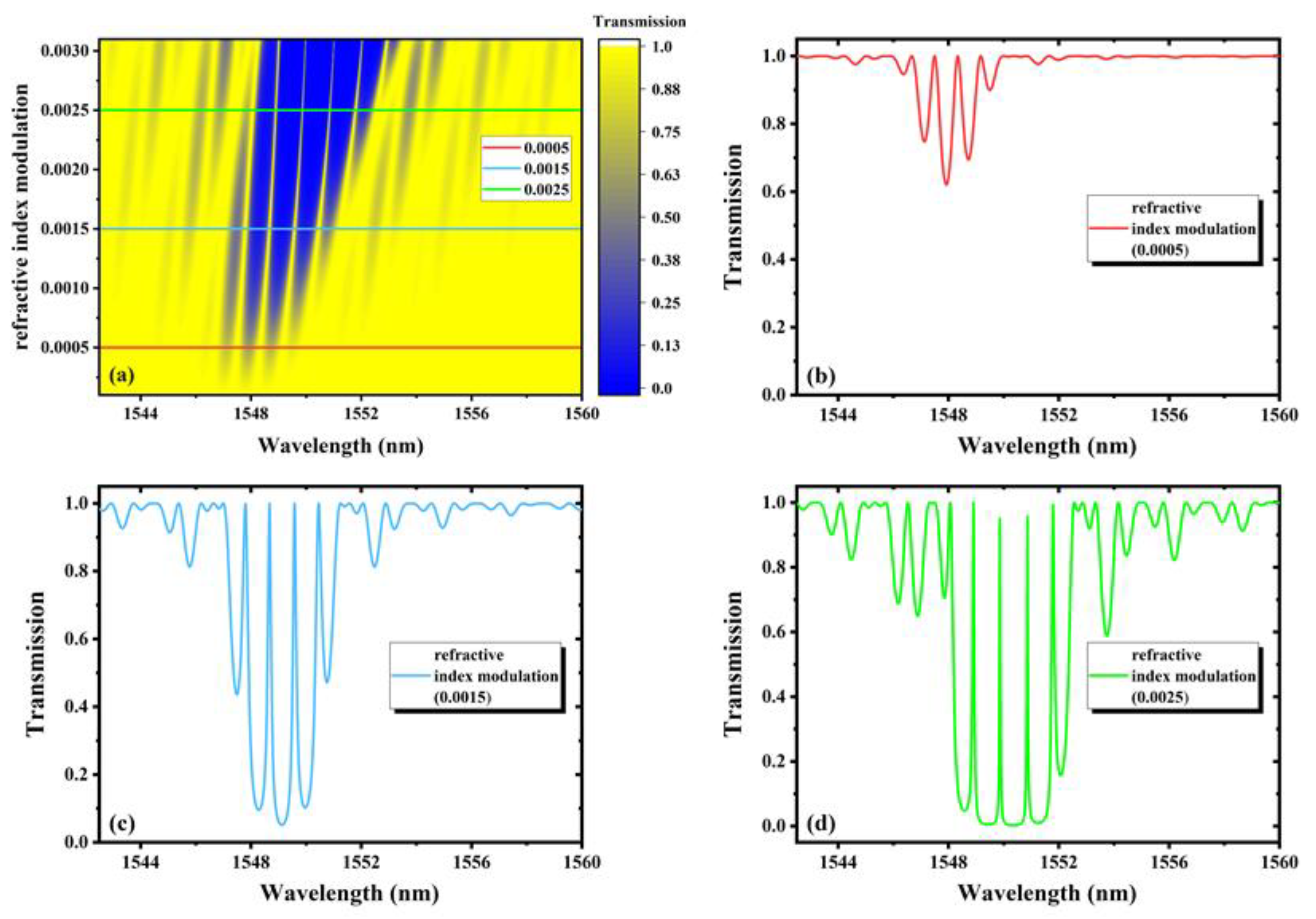
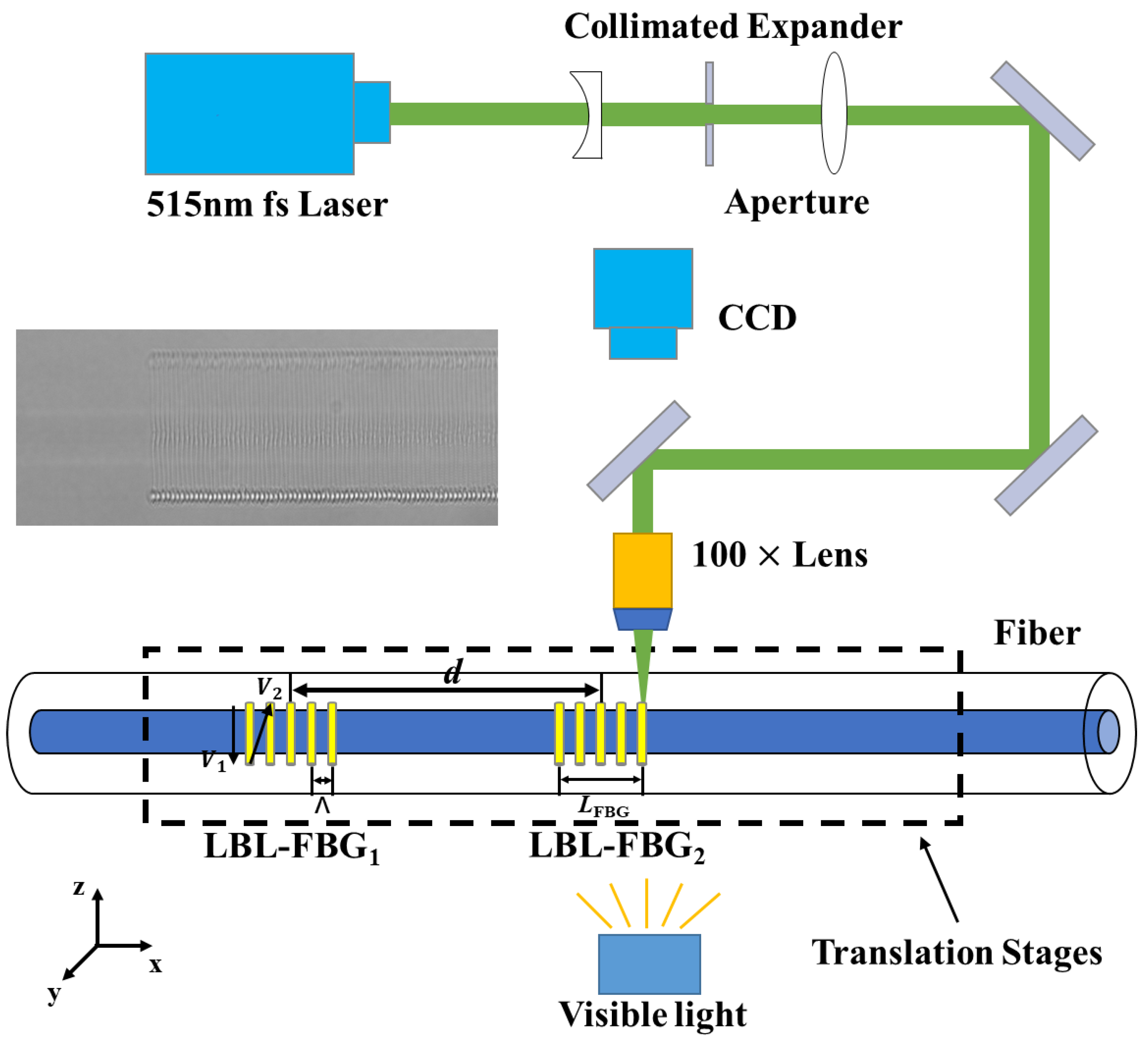
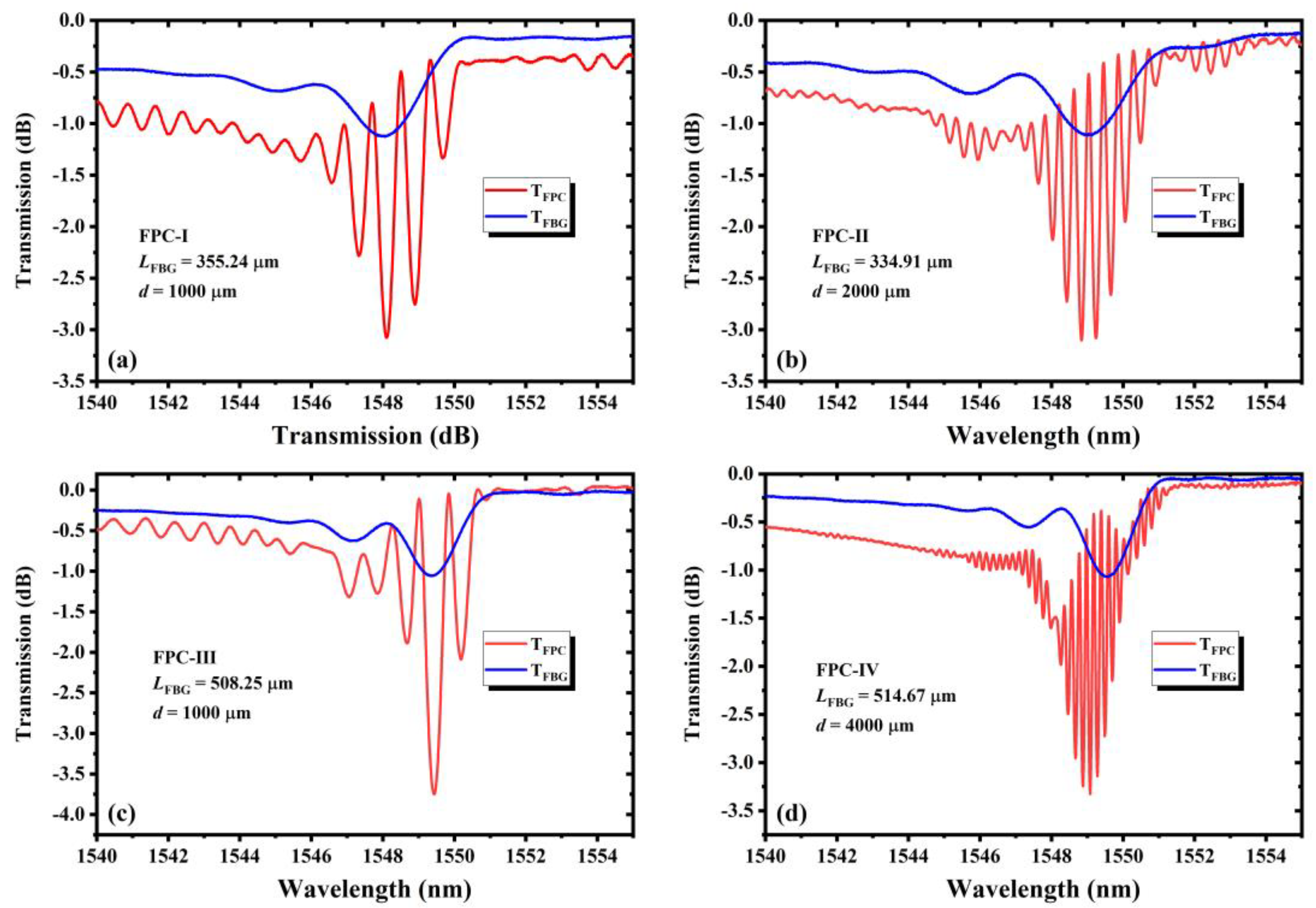
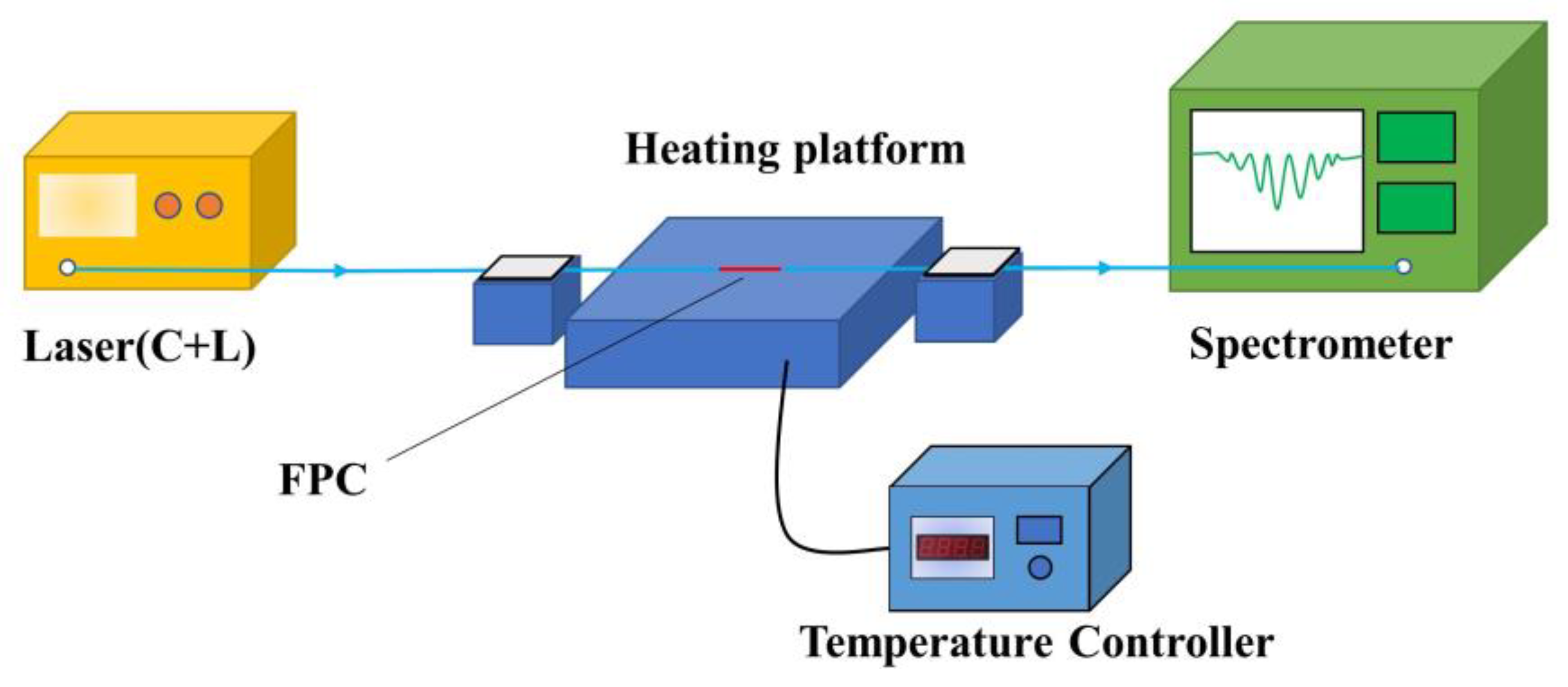
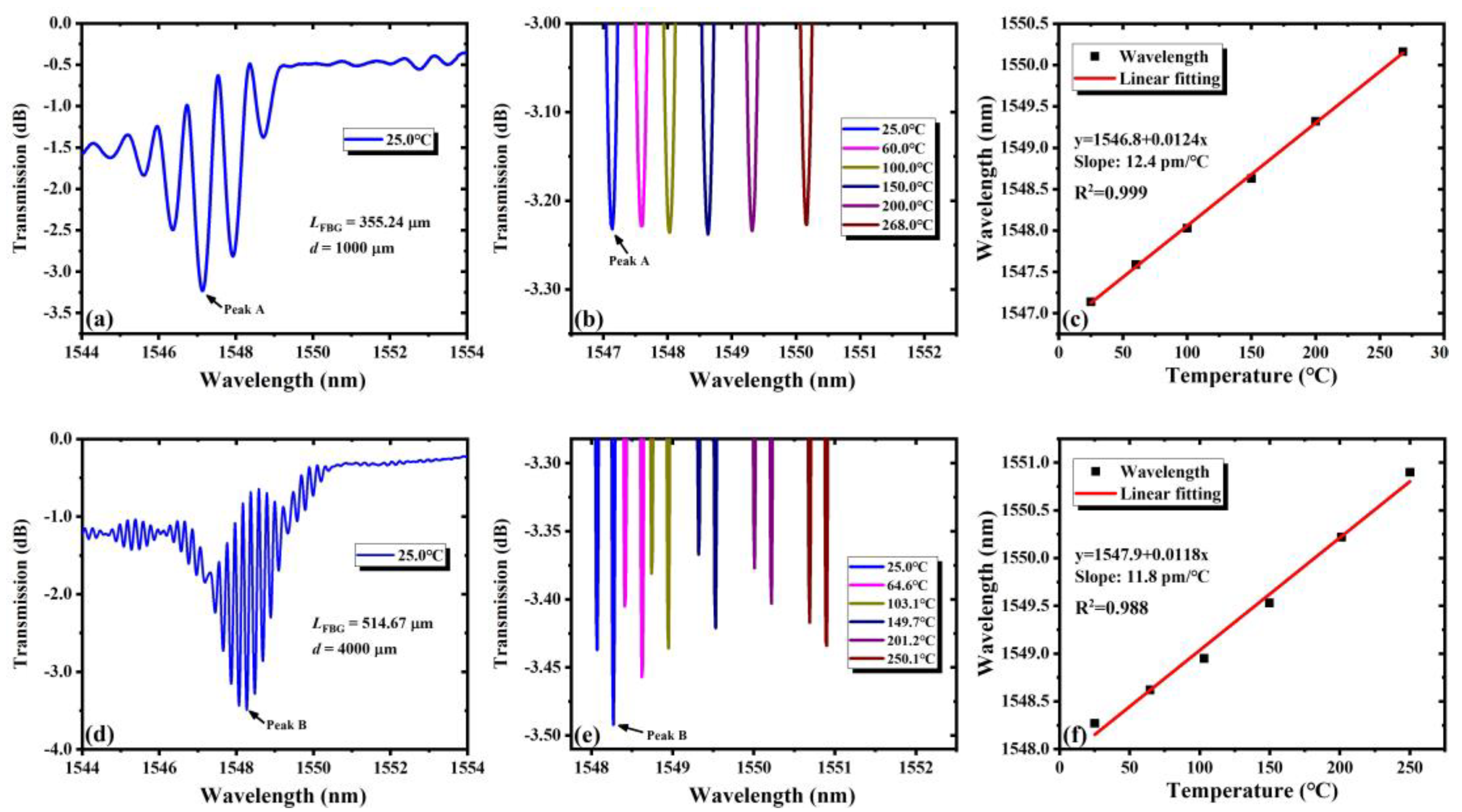


Publisher’s Note: MDPI stays neutral with regard to jurisdictional claims in published maps and institutional affiliations. |
© 2021 by the authors. Licensee MDPI, Basel, Switzerland. This article is an open access article distributed under the terms and conditions of the Creative Commons Attribution (CC BY) license (https://creativecommons.org/licenses/by/4.0/).
Share and Cite
Lei, L.; Li, H.; Shi, J.; Hu, Q.; Zhao, X.; Wu, B.; Wang, M.; Wang, Z. Miniature Fabry-Perot Cavity Based on Fiber Bragg Gratings Fabricated by Fs Laser Micromachining Technique. Nanomaterials 2021, 11, 2505. https://doi.org/10.3390/nano11102505
Lei L, Li H, Shi J, Hu Q, Zhao X, Wu B, Wang M, Wang Z. Miniature Fabry-Perot Cavity Based on Fiber Bragg Gratings Fabricated by Fs Laser Micromachining Technique. Nanomaterials. 2021; 11(10):2505. https://doi.org/10.3390/nano11102505
Chicago/Turabian StyleLei, Luohao, Hongye Li, Jing Shi, Qihao Hu, Xiaofan Zhao, Baiyi Wu, Meng Wang, and Zefeng Wang. 2021. "Miniature Fabry-Perot Cavity Based on Fiber Bragg Gratings Fabricated by Fs Laser Micromachining Technique" Nanomaterials 11, no. 10: 2505. https://doi.org/10.3390/nano11102505
APA StyleLei, L., Li, H., Shi, J., Hu, Q., Zhao, X., Wu, B., Wang, M., & Wang, Z. (2021). Miniature Fabry-Perot Cavity Based on Fiber Bragg Gratings Fabricated by Fs Laser Micromachining Technique. Nanomaterials, 11(10), 2505. https://doi.org/10.3390/nano11102505




